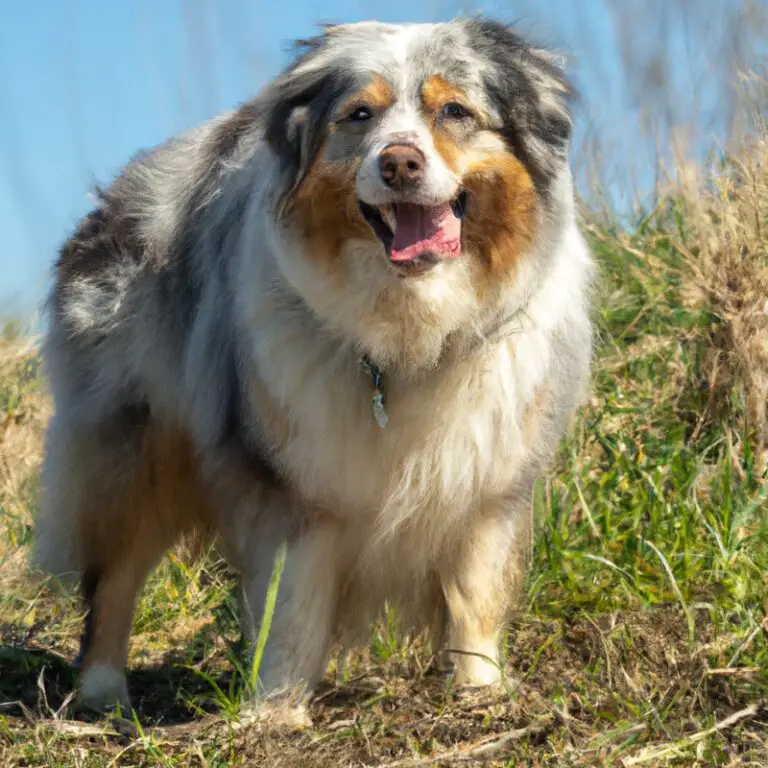What Are The Exercise Needs Of An Australian Shepherd In a Rural Backyard?
Key Takeaways:
- Australian Shepherds in rural backyards require high levels of exercise to maintain their physical and mental well-being.
- Daily exercise should include both physical activities, such as running and playing, as well as mental stimulation, such as training and puzzle toys.
- Australian Shepherds thrive on activities that mimic their natural herding instincts, like agility and obedience training.
- Regular exercise helps prevent behavioral issues, such as boredom-induced destructive behavior, in Australian Shepherds.
Are you lucky enough to call an Australian Shepherd your furry companion? These energetic and intelligent dogs are a joy to have, but they do come with some unique exercise needs.
In this article, I’ll be diving deep into what makes Australian Shepherds tick when it comes to physical activity in a rural backyard.
We’ll explore their breed characteristics, dive into the factors that affect their exercise needs, and provide recommendations for suitable exercise activities that will keep them happy and fulfilled. So, grab a cup of coffee and let’s get started on ensuring your Aussie gets the exercise they need to thrive!
| Exercise Needs | |
| Frequency | Active daily exercise |
| Intensity | High energy and vigorous activity |
| Duration | 1-2 hours per day |
| Type | Running, fetching, agility training, herding activities |
| Benefits | Physical and mental stimulation, prevents behavioral issues, maintains a healthy weight |
| Considerations | Ensure a secure backyard environment, provide mental challenges alongside physical exercise |
Understanding the Australian Shepherd breed
Overview of the Australian Shepherd breed
The Australian Shepherd is a versatile and intelligent breed that is known for its herding abilities. They are medium-sized dogs with a well-balanced and muscular build.
Australian Shepherds have a dense double coat that comes in various colors, including black, blue merle, red merle, and red.
They are known for their beautiful and expressive eyes, which can be blue, amber, or brown. In terms of exercise needs, Australian Shepherds are highly energetic and require regular physical and mental stimulation.
They have a strong herding instinct and thrive in an active environment.
Daily exercise is important to prevent boredom and to keep them happy and healthy. Australian Shepherds are highly intelligent and easily trainable.
They excel in various dog sports and activities such as agility, obedience, and herding trials.
Mental stimulation is just as important for this breed as physical exercise. Puzzle toys, obedience training, and interactive games can help keep their minds sharp.
Living in a rural backyard can provide ample space for Australian Shepherds to run and play.
However, it is essential to ensure that the backyard is securely fenced to prevent them from wandering off. Providing them with space to explore and engage in natural behaviors is important for their overall well-being.

Physical characteristics of Australian Shepherds
Australian Shepherds are medium-sized dogs with strong and athletic builds. They have a double coat, with a dense, weather-resistant outer coat and a soft undercoat.
Their coat can come in a variety of colors, including black, red, blue merle, and red merle.
Australian Shepherds have expressive eyes, usually blue or amber, which give them a lively and intelligent look. They have a moderate-length tail, often naturally bobbed or docked to a shorter length.
These dogs have a muscular and well-proportioned body, with a slightly longer than tall stance.
Overall, Australian Shepherds have a striking and vibrant appearance that complements their energetic personality.
Exercise requirements of Australian Shepherds
Australian Shepherds are an energetic and active breed that require plenty of exercise to stay happy and healthy. They have high exercise requirements and need at least 60 minutes of physical activity each day.
Regular exercise helps to burn off their energy, prevent boredom and behavioral issues, and keep them mentally stimulated.
This breed’s exercise needs can be met through various activities such as walking, running, hiking, playing fetch, and participating in dog sports like agility or flyball. It is important to provide both physical and mental stimulation to keep them engaged and satisfied.
Remember to adjust the intensity and duration of exercise based on your dog’s age, health, and activity level.
Consulting with a veterinarian can help determine the appropriate exercise routine for your Australian Shepherd.

Factors affecting exercise needs
Age and activity level of Australian Shepherds
The exercise needs of Australian Shepherds can vary depending on their age and activity level. Just like humans, Australian Shepherds have different energy levels and exercise requirements at different stages of their life.
Puppies and young Australian Shepherds have high energy levels and are generally more active.
They require more exercise to burn off their excess energy and keep them mentally stimulated. Regular playtime, walks, and short training sessions can help meet their exercise needs and tire them out.
Adult Australian Shepherds also have high energy levels and require daily exercise to keep them happy and healthy.
They need a combination of physical exercise and mental stimulation to burn off energy and prevent behavioral issues. Activities such as running, hiking, playing fetch, and agility training are great ways to keep them active and engaged.
Senior Australian Shepherds may have lower energy levels and may not require as much exercise as they did when they were younger.
However, it is still important to provide them with regular low-impact exercise to keep their muscles strong and maintain their overall health. Gentle walks, swimming, and interactive puzzle toys can be suitable for older Australian Shepherds.
Remember to consult with your veterinarian to determine the appropriate exercise routine for your Australian Shepherd based on their age, health condition, and activity level.
It’s always important to observe your dog’s behavior and adjust their exercise accordingly. Regular exercise not only helps keep them physically fit but also strengthens the bond between you and your furry friend.
Health conditions and potential limitations
Australian Shepherds are generally healthy dogs, but like any breed, they can have certain health conditions and potential limitations that may affect their exercise needs. One common health concern in Australian Shepherds is hip dysplasia, a condition that affects the hip joint and can cause pain and mobility issues.
This condition may require modifications to an Australian Shepherd’s exercise routine, such as avoiding high-impact activities like jumping and running on hard surfaces.
Another potential limitation for Australian Shepherds is eye problems, including progressive retinal atrophy and cataracts. These conditions can impair their vision and may affect their ability to navigate obstacles or participate in activities that rely heavily on sight.
Regular veterinary check-ups and appropriate eye care can help manage these conditions.
Additionally, Australian Shepherds may have a genetic predisposition to certain hereditary conditions, such as epilepsy and cancer. While exercise itself does not directly impact these conditions, it’s important to be aware of the potential limitations they may impose on your dog’s overall health and well-being.
As a responsible owner, it is crucial to understand your Australian Shepherd’s individual health conditions and potential limitations.
This will help you tailor their exercise routine to meet their specific needs, ensuring they can stay active and healthy while minimizing any risks or discomfort they may experience. Regular communication with your veterinarian is key in addressing any health concerns and determining suitable exercise options for your Australian Shepherd.
Impact of living in a rural backyard
Living in a rural backyard can have a significant impact on the exercise needs of an Australian Shepherd. In a rural setting, there is often more space for the dog to roam and explore, which can be beneficial for their physical and mental stimulation.
With more room to run, jump, and play, Australian Shepherds can engage in high-energy activities that cater to their active nature.
The open space also allows them to utilize their natural herding instincts. Additionally, a rural backyard can provide various opportunities for different types of exercise.
For example, you can set up agility equipment or obstacles to challenge and entertain your Australian Shepherd.
This not only helps in fulfilling their exercise needs but also keeps them mentally stimulated. However, living in a rural backyard also comes with certain considerations.
It’s essential to ensure that the backyard is securely fenced to prevent your Australian Shepherd from wandering off into potentially dangerous situations.
This is particularly important for Australian Shepherds, as they have a strong herding instinct and may be inclined to chase after animals or cars. Another factor to consider is weather conditions.
In rural areas, the climate may be more extreme, with hot summers or harsh winters.
It’s crucial to provide your Australian Shepherd with shade and shelter during hot weather and appropriate protection from extreme cold temperatures.
Recommended exercise activities
Daily exercise recommendations
To meet the exercise needs of an Australian Shepherd in a rural backyard, it’s important to establish a daily exercise routine. These high-energy dogs require at least 1 to 2 hours of physical activity every day.
Here are some daily exercise recommendations to keep your Australian Shepherd happy and healthy:
- Take them for long walks: A long walk is a great way to provide both physical and mental stimulation for your Australian Shepherd. Aim for at least 30 minutes to an hour of brisk walking or jogging each day.
- Engage in interactive play sessions: Australian Shepherds love to play, so make sure to set aside time for interactive play sessions. Play fetch, tug-of-war, or engage in other games that involve running and chasing.
- Provide mental stimulation: In addition to physical exercise, Australian Shepherds need mental stimulation to prevent boredom. Incorporate puzzle toys, obedience training, or interactive feeding toys to keep their minds engaged.
- Consider agility training: Australian Shepherds excel in agility training due to their intelligence and athleticism. Set up an agility course in your backyard or enroll them in classes to keep them physically and mentally challenged.
- Explore off-leash activities: If your rural backyard is enclosed and safe, give your Australian Shepherd opportunities for off-leash exploration. They can run, run and play freely, which allows them to release energy and satisfy their herding instincts.
Remember, the exercise needs of Australian Shepherds can vary, so pay attention to your individual dog’s energy levels and adjust the exercise routine accordingly. By providing daily exercise and mental stimulation, you’ll help keep your Australian Shepherd healthy, happy, and well-behaved.

Mental stimulation exercises
Mental stimulation exercises are essential for Australian Shepherds to keep their intelligent minds engaged. Here are some activities to provide mental stimulation for your Aussie:
- Puzzle toys: These toys challenge your dog’s problem-solving skills and keep their minds active. Fill them with treats or kibble, and let your Aussie figure out how to get to the reward.
- Hide-and-seek: Hide treats or toys around the backyard and encourage your dog to sniff them out. This game taps into their natural instincts and provides mental and physical stimulation.
- Training sessions: Australian Shepherds love learning new tricks and commands. Conduct short training sessions every day to keep their minds sharp and reinforce good behavior.
- Interactive play: Engage in interactive play with your Aussie using toys like tug ropes or balls. This not only provides mental stimulation but also strengthens the bond between you and your dog.
- Scent work: Australian Shepherds have a keen sense of smell. You can hide treats or toys in different locations and let your dog use their scenting abilities to find them.
Remember, mental stimulation exercises are just as important as physical exercise for Australian Shepherds. By incorporating these activities into your daily routine, you can keep your Aussie happy, healthy, and mentally sharp.
Off-leash activities and games
Off-leash activities and games can be a great way to meet the exercise needs of your Australian Shepherd in a rural backyard. Here are some ideas to keep your dog engaged and active:
- Fetch: Playing a game of fetch can be a fantastic off-leash activity for your Australian Shepherd. They are natural retrievers and will love sprinting after the ball and bringing it back to you.
- Frisbee: Australian Shepherds are known for their agility, and playing frisbee can be a fun way to channel their energy. Just make sure to use a soft and safe frisbee designed for dogs.
- Hide and Seek: This game is not just for kids! Hide and seek can be a mentally stimulating game for your Australian Shepherd. Have someone hold your dog while you hide, and then call them to find you.
- Agility Course: Set up an agility course in your backyard using tunnels, hurdles, and weave poles. This will provide both physical and mental exercise for your Australian Shepherd while keeping them entertained.
- Treibball: Treibball is a herding game that involves pushing large exercise balls into a goal. It’s a great way to satisfy your Australian Shepherd’s natural herding instincts while giving them a good workout.
- Water activities: If you have a pool or a large body of water nearby, swimming can be a fantastic off-leash activity for your Australian Shepherd. Just make sure your dog is comfortable in the water and always supervise them.
- Puzzle toys: While not strictly an off-leash activity, puzzle toys can provide mental stimulation and keep your Australian Shepherd entertained during downtime. Fill them with treats or kibble to engage your dog’s problem-solving skills.
Remember, safety is paramount when engaging in off-leash activities. Make sure your backyard is secure and free from any hazards.
Always supervise your dog and make sure they are well-trained and responsive to commands.
Creating a suitable exercise environment
Assessing the size and safety of the backyard
To ensure the exercise needs of an Australian Shepherd are met, it’s important to assess the size and safety of your backyard. Regarding size, consider if the space is large enough for your dog to move around freely and engage in various physical activities.
Australian Shepherds are known for their high energy levels, so ample space to run and play is essential.
Safety is another crucial factor to consider. Check for any potential hazards such as sharp objects, toxic plants, or small gaps where your dog could escape.
Make sure the fencing is secure and tall enough to prevent your Australian Shepherd from jumping over.
Additionally, assess the overall terrain and any potential dangers like holes, uneven ground, or slippery surfaces that may cause injury. Providing a safe and obstacle-free environment is important to prevent accidents during exercise sessions.
Taking the time to evaluate the size and safety of your backyard will help create an exercise space that meets the needs of your Australian Shepherd while keeping them safe and happy.
Suitable fencing options for a rural backyard
When it comes to creating a suitable exercise environment for your Australian Shepherd in a rural backyard, having the right fencing is crucial. Here are some suitable fencing options to consider:
- Solid Wood or Vinyl Fencing: These types of fences provide privacy and security for your dog. They also help prevent your Australian Shepherd from being distracted or agitated by external stimuli, such as wildlife or other animals passing by.
- Chain-Link Fencing with Privacy Slats: If you prefer a more open feel, you can opt for chain-link fencing with privacy slats. These slats can be inserted into the chain-link mesh, creating a partial barrier that still allows airflow and visibility. This option provides a balance of security and visibility.
- Electric Fencing: Electric fences can be a useful option in rural areas, especially if you have a larger property. These fences deliver a mild electric shock when your dog gets too close to the boundaries, serving as a deterrent. However, it is important to properly train your Australian Shepherd to avoid unnecessary harm.
- Reinforced Agricultural Fencing: For rural properties with livestock or larger animals, reinforced agricultural fencing may be necessary to keep your Australian Shepherd contained. These fences are typically made of sturdy materials like woven wire or barbed wire, ensuring durability and security.
Remember, regardless of the type of fencing you choose, it’s crucial to regularly inspect and maintain the fence to prevent any potential escape routes or damage. And always supervise your Australian Shepherd while they are outside to ensure their safety.
Incorporating agility equipment or obstacles
Incorporating agility equipment or obstacles into your Australian Shepherd’s exercise routine can be a great way to keep them engaged and physically active. Agility equipment such as jumps, tunnels, and weave poles can help improve your dog’s coordination, strength, and overall agility.
Adding these obstacles to your backyard provides a fun and challenging environment for your Australian Shepherd to burn off energy.
You can easily find agility equipment online or at pet stores, or even build your own with some DIY skills. Start with simple obstacles like jumps and tunnels and gradually introduce more complex ones as your dog becomes comfortable.
Use positive reinforcement and rewards to encourage your Australian Shepherd to complete the obstacles.
Agility training not only provides physical exercise but also mental stimulation, which is important for the intelligent and active nature of Australian Shepherds. It helps prevent boredom and can strengthen the bond between you and your furry friend.
Remember to always supervise your dog during agility sessions and ensure they are not pushing themselves too hard.
Start with short sessions and gradually increase the duration as their fitness level improves. Incorporating agility equipment or obstacles into your Australian Shepherd’s exercise routine can be a fun and rewarding experience for both of you.
So go ahead, get creative, and watch your dog enjoy the challenges and excitement of agility training!
Tips for exercising Australian Shepherds in a rural backyard
Establishing a regular exercise routine
To establish a regular exercise routine for your Australian Shepherd in a rural backyard, consistency is key. Start by setting aside dedicated times each day for exercise.
This helps create a routine and makes it easier for both you and your dog to stick to it.
When planning your exercise routine, consider the specific exercise needs of Australian Shepherds. They are an energetic breed that requires ample physical activity to stay healthy and content.
Aim for at least 60 minutes of exercise every day.
Mix up the activities to provide mental stimulation as well. Australian Shepherds are intelligent dogs and enjoy mental challenges.
Incorporate obedience training, puzzle toys, and other mentally stimulating activities into your routine.
Remember to vary the exercises to keep things interesting. Take your Australian Shepherd for walks, play games like fetch or frisbee, and try out agility activities in your backyard.
Providing a variety of exercises helps prevent boredom and keeps your dog engaged.
It’s also important to monitor your dog’s behavior during exercise. Australian Shepherds are prone to overexertion, especially in hot weather.
Be mindful of their limits and ensure they have access to water and shade during exercise sessions.
With dedication and consistency, you can establish a regular exercise routine that meets the needs of your Australian Shepherd in your rural backyard. Keep in mind that every dog is unique, so it may take some trial and error to find the activities that your dog enjoys the most.
Training tips for recall and command responsiveness
Training an Australian Shepherd for recall and command responsiveness is essential to ensure their safety and well-being. Here are some effective tips for successful training:
- Use positive reinforcement: Reward your Australian Shepherd with treats, praise, and affection when they respond correctly to your commands or come when called. This positive association will motivate them to obey your instructions.
- Start indoors: Begin training sessions in a calm and controlled environment, such as your home. Teach basic commands like sit, stay, and come using treats and consistent verbal cues. Gradually increase the distractions and move to outdoor spaces.
- Practice consistent commands: Use clear and consistent verbal cues for each command. For example, use “come” instead of “here” or “over here.” This helps your Australian Shepherd to understand and associate specific actions with the relevant command.
- Reinforce recall in different environments: Once your Australian Shepherd responds reliably in familiar surroundings, gradually introduce them to different environments. Start with a quiet park and progress to more challenging locations. This will help them generalize the recall command.
- Use a long training lead: When training recall, use a long training lead to give your Australian Shepherd more freedom while still maintaining control. This allows you to give gentle corrections if needed, reinforcing their understanding of the command.
- Be patient and consistent: Training takes time and consistency. Practice in short sessions throughout the day, focusing on positive reinforcement and repetition. Avoid punishment or negative reinforcement, as this can undermine their trust and hinder their progress.
- Proof the recall command: Once your Australian Shepherd consistently responds to recall commands, practice in increasingly distracting environments. Use toys, other dogs, or other stimuli to simulate real-life situations and reinforce their ability to listen and respond in any situation.
- Seek professional help if needed: If you’re struggling with training or your Australian Shepherd exhibits challenging behaviors, consider consulting a professional dog trainer. They can provide valuable guidance, tailor training techniques to your dog’s individual needs, and help address specific challenges.
Remember, training should be a positive and enjoyable experience for both you and your Australian Shepherd. Patience, consistency, and positive reinforcement are key to developing a strong recall and command responsiveness.
Socialization opportunities outside the backyard
Socialization is an essential aspect of raising an Australian Shepherd. While socializing your dog within the confines of your backyard is a great start, it’s also important to expose them to the outside world.
Taking your Australian Shepherd for regular walks in different environments, such as parks or neighborhoods, provides valuable socialization opportunities.
These outings allow your Australian Shepherd to encounter new people, animals, sights, and sounds. Meeting other dogs and their owners can help your dog develop good social skills and learn how to interact appropriately.
It also helps to build their confidence and reduce any anxiety they may have.
Doggy socialization classes or meetups can be another great option to expose your Australian Shepherd to various dogs in a controlled environment. This allows them to learn important cues and body language, while also promoting positive play behavior.
In addition to walks and socialization classes, you can also consider taking your Australian Shepherd to public events or pet-friendly establishments.
This exposes them to different situations and helps them become more comfortable in various settings. Remember, socialization should be a positive experience for your Australian Shepherd.
Take things at their pace, always reward good behavior, and use positive reinforcement techniques during these outings.
This will help ensure that they associate socialization with pleasant experiences and continue to be well-adjusted and friendly dogs.
Potential challenges and solutions
Weather considerations and alternative exercise options
When it comes to exercising an Australian Shepherd in a rural backyard, weather considerations are important. Extreme heat or cold can make it uncomfortable or unsafe for your dog.
In hot weather, exercise early in the morning or late in the evening when it’s cooler.
Make sure to provide plenty of shade and access to fresh water. In cold weather, consider alternative exercise options, such as playing indoor games or setting up an obstacle course inside.
Remember to tailor the exercise routine based on the weather conditions to keep your Australian Shepherd happy and healthy.
Dealing with excessive barking and herding instincts
Excessive barking and herding instincts are common challenges faced by Australian Shepherd owners. To deal with excessive barking, providing mental stimulation and physical exercise can help redirect their energy.
Teaching them the “quiet” command using positive reinforcement can also be effective.
Addressing herding instincts can be done by redirecting their focus to appropriate activities like playing fetch or participating in agility training. Teaching a reliable recall command is crucial to ensure they listen and follow commands.
Providing them with tasks and jobs to do, such as learning obedience or participating in herding trials, can help satisfy their natural instincts.
It’s important to remember that every dog is unique, so it may take time and patience to find the best strategies that work for your Australian Shepherd. Professional training or seeking guidance from a dog behaviorist may also be beneficial.
Finding additional outlets for energy release
To provide additional outlets for energy release, you can consider the following options for your Australian Shepherd:
- Interactive Toys: Invest in interactive toys that require mental stimulation and physical activity. Puzzle toys or treat-dispensing toys can keep your Australian Shepherd engaged and entertained.
- Dog Sports: Engage your dog in various dog sports such as agility, flyball, or obedience training. These activities not only provide physical exercise but also stimulate their minds and challenge their problem-solving skills.
- Off-Leash Adventures: Take your Australian Shepherd on regular off-leash adventures to safely explore their surroundings. This can include visits to dog parks, hiking trails, or designated off-leash areas. Always ensure they have good recall and are well-behaved around other dogs.
- Swimming: If you have access to a safe water source, swimming can be an excellent exercise option for Australian Shepherds. It is a low-impact activity that helps to release their energy, while being gentle on their joints.
- Herding Trials: Australian Shepherds have strong herding instincts, and participating in herding trials can be an excellent outlet for their energy. Look for local clubs or trainers who offer herding trials and training sessions.
- Doggy Playdates: Arrange playdates with other well-behaved dogs. Social interaction and play are vital for your Australian Shepherd’s mental and physical well-being. It allows them to burn off excess energy while enjoying the company of other dogs.
Remember, finding additional outlets for energy release is crucial for keeping your Australian Shepherd happy and healthy. By providing a variety of physical and mental activities, you can ensure that your dog remains mentally stimulated and physically active.
Final Verdict
Understanding the exercise needs of an Australian Shepherd in a rural backyard is crucial for their overall well-being. These energetic and intelligent dogs thrive with regular physical and mental stimulation.
Daily exercise, mental stimulation exercises, and off-leash activities are highly recommended.
Creating a suitable exercise environment with proper fencing and incorporating agility equipment can enhance their exercise experience. By establishing a regular exercise routine, training for recall and command responsiveness, and providing socialization opportunities outside the backyard, challenges such as excessive barking and herding instincts can be managed effectively.
Taking weather considerations into account and finding additional outlets for energy release are also important.
By implementing these tips, you can ensure a happy and healthy lifestyle for your Australian Shepherd in a rural backyard.








